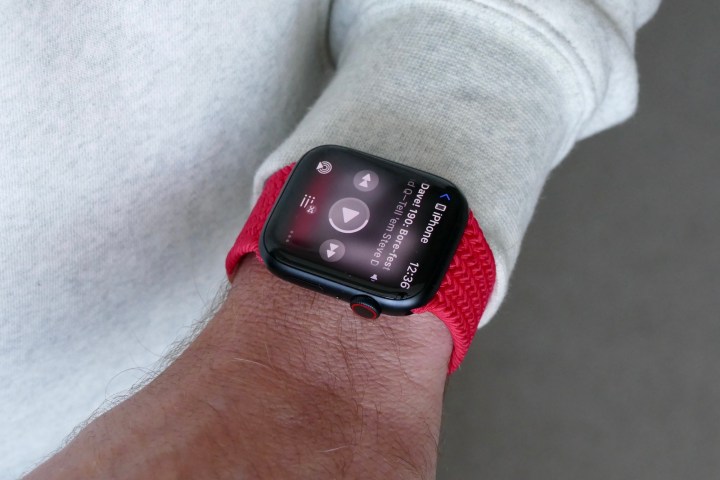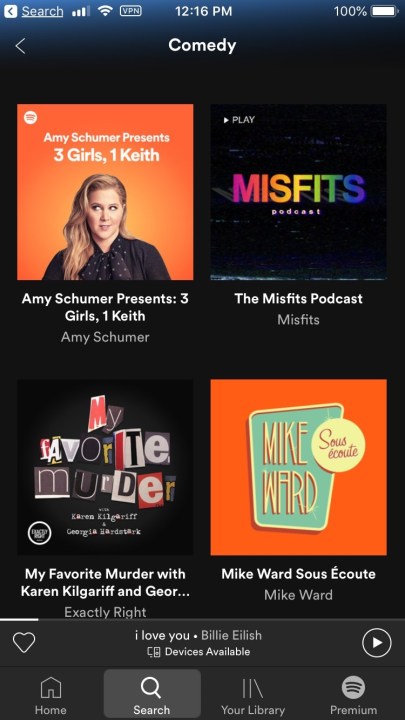Music and podcast-loving owners of the best iPhones will likely know of one eternal battle: the clash of Apple Music vs Spotify. One feels exclusive and powerful for iOS users, at least in its name, but the other has mainstream appeal and gets name-dropped on the regular. But which is more fun to use, will help you discover fun new music, and sounds better? Sure, you can try the Spotify free trial to see how it runs, but that will only give you half the story.
The question of which these, both among the best music streaming services, is better has become increasingly tough to answer. We’re here to settle the score. Join us below to see which of these juggernaut music-streaming services is right for you.
Spotify Music

Apple Music
Apple Music vs Spotify — Library

Spotify is home to more than 100 million songs and 5 million podcasts, more music than your ears would even know what to do with. The Swedish streaming service also brings all the latest releases, exclusive live sessions, and various new singles right to its New Releases tab each Friday, as well as the Release Radar playlist.
Apple’s service also touts more than 100 million songs, with this size of library becoming more common among streaming services these days. However, Apple has taken steps to secure many more exclusives than the competition, largely because it doesn’t offer a free tier.
There’s another area where Apple Music has a leg up on its competition: integration of the iTunes library. Any music you have — whether previously purchased via the iTunes Store, ripped from a physical CD, or uploaded to iTunes Match — will appear in your Apple Music library, giving you the option to freely browse your own music alongside Apple’s standard catalog. Spotify offers a similar function, relegating your local music files to a separate tab, but you can’t access your local music via broad searches as you can with Apple Music.
Section winner: Apple Music

Apple Music vs Spotify — Audio quality

We also need to discuss the audio quality that comes with streaming songs on both services. For Spotify, the free version of the software streams at AAC 128Kbps via the web player. Download the Spotify app for desktop, mobile, or tablet and it will adjust streaming quality based on your connection, anywhere from 24Kbps to 160Kbps.
Upgrade to Premium, and that boosts quality up to AAC 256Kbps on the web player, and on the apps you’ll get four quality levels maxing out at 320Kbps. Spotify’s promised lossless tier of service is still nowhere to be found.
Apple, on the other hand, has made significant strides in providing free audio quality upgrades for all subscribers. The entire 100 million Apple Music songs are now available in lossless audio. Apple uses ALAC (Apple Lossless Audio Codec), so the music stays true to the original audio file. There are several tiers of lossless audio available, starting with CD quality, 16-bit at 44.1kHz, and going up to 24-bit at 48kHz. There is also a hi-resolution lossless format all the way up to 24-bit at 192kHz. Additionally, last year, Apple made a wide range of its library available in its surround-sound spatial audio format. Enabled by Dolby Atmos coding, spatial audio gives music additional depth, extra compatibility with dynamic head-tracking, and other advantages that have come with the latest iOS updates. It’s also really great through your Apple TV.
Section winner: Apple Music

Apple Music vs Spotify — Music discovery algorithm

With so many songs at the ready, streaming libraries can seem daunting for those who want to find new music. Let’s take a look at how the big players do it.
Spotify
Spotify provides a lot of useful tools for finding new songs to suit your taste. Personalized playlists like Discover Weekly provide fantastic opportunities for subscribers to latch on to new music from artists they never stumbled across on their own. The deep well of base genres to choose from makes new music ripe for the picking, and listeners can personalize playlists simply by liking specific songs as they listen. While Spotify recommends ongoing playlists and channels to new users, including editor-curated playlists for specific tastes, these features are much more limited for free users.
Discover Weekly, in particular, deserves high praise in the streaming world. Added to your feed every Monday morning, the feature delivers a two-hour playlist of personalized music recommendations based on your listening habits, as well as the habits of those who listen to similar artists.
Spotify also gives you the chance to create, share, and follow playlists of any kind — including those shared by friends — with a simple click, along with expertly curated playlists for any mood or genre you’re into to keep things fresh. There’s even a Collaborative Playlist feature that lets you create playlists with your friends that you can all add to and edit.
Spotify is always adding new features to help with discovery, including its DJ feature, which is an AI-generated radio station based on your listening habits that is hosted by a virtual DJ voiced by Xavier “X” Jernigan, Spotify’s head of cultural partnerships.
Apple Music
As for Apple Music, upon creating an account, users are prompted to select some of their favorite artists so the service can get a sense of their tastes. A Listen Now section recommends a variety of music based on your listening history and other activities, including music sent to you from your friends via the Messages app, all organized in the Shared With You tab. These features and more make Apple Music a great option for getting recommendations.
Thankfully, once the process is complete, Apple Music does a great job of curating playlists to appeal to your preferences, so you can vibe out through your headphones. Playlists might be based on genre, artist, or even a particular activity like driving. Apple claims the playlists are curated by a “team of experts.” This cabal of tastemakers — whoever they are — do a good job creating varied playlists that are at once familiar yet fresh, like a mixtape you might get from a friend.
Apple Music’s Apple Music 1 function, which offers live radio 24 hours a day, also plays a major role when it comes to music discovery. It’s refreshing to see Apple move beyond sophisticated algorithms for a human approach to facilitating true music discovery.
In March of 2023, Apple launched its Apple Music Classical service. Available at no cost to Apple Music subscribers (except to those on the Voice plan), it’s a separate app you can download that Apple says offers “the world’s largest classical music catalog” of more than 5 million classical tracks.
Still, Spotify’s hands-off playlists and curated playlists, along with its fantastic Discover Weekly and Release Radar segment, give it the edge. Until Apple Music can compete with this algorithm-based approach, we will give Spotify the win.
Section winner: Spotify Music

Apple Music vs Spotify — Radio

In the app, Spotify did away with the Radio tab of the past but now has an option to create a radio mode for any specific artist, album, playlist, or song. Simply go to the Three-dot menu icon, and choose Go to radio to create one. These radio “stations” can also be saved in the library as playlists.
There’s also assisted playlist creation for a more personalized option than full radio mode. Say, for example, you wanted to create a playlist to accompany you on your morning workouts. Using assisted playlisting, Spotify will use the title you’ve given the playlist (like “Workout”) and pull from suggestions based on your past listening history, as well as recommendations based on songs others have added to their own similar playlists. You can continue to fill your playlists with tracks, or Spotify can autofill them once you’ve chosen a few to start with. Users are also able to search and preview songs before adding them to a playlist.
In an age that prioritizes automation, Apple Music’s preference for the human touch helps with radio-style programming. This philosophy is embodied in Apple Music 1, Apple Music’s premier radio station that runs nonstop music mixed by DJs on live radio shows.
The most intriguing shows on Apple Music 1 are those hosted by notable musicians such as Annie Clark (St. Vincent), Haim, and Q-Tip (A Tribe Called Quest). These shows provide listeners with a unique look into the tastes of artists they admire.
Beyond Apple Music 1, Apple Music has some more generic radio stations for those who simply want to listen to, say, classic rock, jazz, or Top 40 hits. There are also non-music stations, such as BBC News and ESPN, creating a menagerie of options that are hard to beat.
Section winner: Apple Music

Apple Music vs Spotify — Podcasts
Although Apple Music and Spotify are primarily music apps, podcasts have a natural home on audio platforms. Spotify has been the fastest-growing podcast destination since launching the feature in 2015. In fact, Spotify currently boasts the most podcasts of any service, offering 5 million as of 2022’s fourth quarter.
You’ll find tons of popular programs, and there are enough compelling originals that podcasts alone may entice you to stay. The Spotify app handles the task beautifully, with timers and playback speed controls available to assist your binge-listening sessions.
Apple Music doesn’t have any such functionality built-in. Podcasts were split off into their own app right around the time Apple started breaking iTunes into little bits and pieces, and that’s where they’ll stay for the foreseeable future.
Section winner: Spotify Music

Apple Music vs Spotify — Price

As of July 2023, Spotify increased the price of all of its service tiers. The Spotify Premium Individual service now costs $11 per month and is now on par with Apple Music.
Right now, new subscribers get Apple Music free for one month. Apple Music also offers a Family plan for $17 with access for up to six people. Spotify also has a Duo plan for $15 for a couple subscribing together and a Family plan for $17 that offers up to six accounts along with Spotify Kids and parental controls.
There’s another way to save some cash on both services — student plans. New users with an applicable student email can get a discounted monthly subscription of just $6. Both add a bit more for that bargain, with Spotify offering students ad-supported Hulu access with Showtime, while Apple will hook the studious up with Apple TV+.
Apple does not have a free, ad-based tier like Spotify. The majority of Spotify’s users listen for free, and they can still play songs on-demand as long as they are willing to put up with ads (unskippable on the app but can be muted on the web app) – with some extra limitations for mobile devices. Not to mention, new Spotify users can currently nab one month of Premium for free.
Section winner: Spotify Music

Apple Music vs Spotify — User interface and mobile experience

Apple Music’s mobile interface is minimalist and easy to use. The Library contains all the music you own and can be accessed in this tab, and you can easily filter by Playlists, Artists, Albums, Songs, and Downloaded music, just in case you don’t want to waste your precious mobile data.
Tapping on the Listen Now tab now brings up several different personalized options. The Top Picks and the daily themed playlists provide even more ways to discover new tunes, while the Browse tab gives you an avenue to explore popular music, videos, and Apple exclusives. The Radio tab gives users access to hundreds of Apple-curated music stations, broken up by genre, artist, and host. Those looking for something specific can use the Search tab, which allows you to quickly search through either your personal library or the Apple Music library.
Apple has also integrated Siri with Apple Music, allowing subscribers to issue voice commands through their Apple TV, iPhone, or Mac. It’s a cool feature that Android users won’t get, as they don’t have access to Siri. Additionally, Apple’s Sing feature adds some fun to the app, allowing users to turn their devices into a veritable karaoke machine that strips the vocals out of select tracks so you can sing over it.
The Android version of Apple Music is pretty much the same as the iOS version, although it works best on iOS, especially with the added Siri functionality.
Spotify, on the other hand, is more device-agnostic and has long been the industry leader in terms of sheer usability. The mobile and desktop applications provide users with an easy way to browse music, access playlists, listen to internet radio, and discover new music.
On mobile, all your bidding is done within three tabs — Home, Search, and Your Library. Each section features its own set of straightforward subcategories, which gives users easy access to the service’s many features. The search window actively populates the results field, much like Google’s search engine, often providing exactly what you’re looking for after typing just a few characters. Spotify also has middling support for voice activation through devices like the Amazon Echo or Google Home.
In March of 2023, Spotify carried out its first redesign in a decade, adding new discovery features and a new scrolling, image-heavy, interactive visual look reminiscent of TikTok and Instagram.
For those allergic to apps, Spotify has long offered a web player that, while not quite as intuitive as the native desktop app, offers quick, lightweight access. Apple has followed suit with a web player of its own in beta. Both have the option to display the lyrics of the song playing.
Apple Music offers one of the most impressive music services around, but you have to be all-in on Apple’s smartphones, tablets, computers, and streaming boxes to get the most out of it. We give Spotify the edge here for its clean and easy user experience, ubiquity, and increased availability of third-party integrations.
Section winner: Spotify Music

Apple Music vs Spotify — Social features
Spotify’s social functions allow subscribers to follow friends (if you’re both on Facebook and connect your Spotify accounts) and see what they listen to and who they follow. It also gives users the ability to share or recommend playlists, along with the ability to publish their listening history to Facebook, which then allows their Facebook friends to like or comment on the activity. Add to that the Collaborative Playlist feature in which you and your friends can add to and edit playlists, and Spotify’s social features are pretty robust.
Apple Music’s social functionality is few and far between and includes the ability to see what your friends are listening to and easy playlist sharing.
Even without messaging, Spotify’s solid social media integration, as well as the ability to see what friends and followers are listening to, gives the service the upper hand.
Section winner: Spotify Music

Apple Music vs Spotify — Workout modes

Many people listen to music while running, and both Apple Music and Spotify are loaded with workout-themed playlists.
Spotify used to have built-in workout functions but has since offloaded some of those features to other apps. For example, on smartphones with the appropriate sensors, Spotify can be used in conjunction with running apps such as Runkeeper to automatically select a playlist that matches the user’s running tempo. The integration is a welcome one for people who don’t want to plan out their music selection before they hit the track — though it’s a shame the functionality is no longer natively supported in-app.
For Apple Music subscribers, there’s Apple Fitness+, which uses data from a user’s Series 3 (or later) Apple Watch to create customized workout routines and workout playlists that can be listened to in Apple Music. Apple Music users can use the Search tab to find some motivational Apple Fitness+ playlists. With Apple Fitness+ Studio Series, users can even search for workout tunes based on the type of exercise they’re launching into. Everything from meditative music for yoga to dance and electronic music for rowing and kickboxing is available.
Section winner: Apple Music

Apple Music vs Spotify — Offline downloads
Apple Music lets you download music for offline playback across 10 different devices at once, with a maximum of 100,000 songs. Spotify lags in this area, with its restriction sitting at 10,000 songs on up to five devices.
Section winner: Apple Music

Overall winner
Spotify Music
Spotify is the winner here. While Apple Music has made some serious strides, Spotify still reigns supreme. Its user interface is accessible and uncluttered, making playlist management simple. Its music discovery playlists, especially Discover Weekly, keep it brilliantly fresh, and it’s also free for those who can’t yet commit. Apple Music’s larger catalog, exclusive releases, human-curated playlists, and features like Apple Music 1 make it a serious contender. Depending on what features are important to you, you may choose differently, but for now, Spotify still has the edge in which music streaming service is better.
Full Specs
 Spotify Music |
 Apple Music |
|
|---|---|---|
| Duo | $15 per month | N/A |
| Family | $17 per month | $17 per month |
| Individual | $11 per month | $11 per month |
| Student | $6 per month | $6 per month |
Editors’ Recommendations






